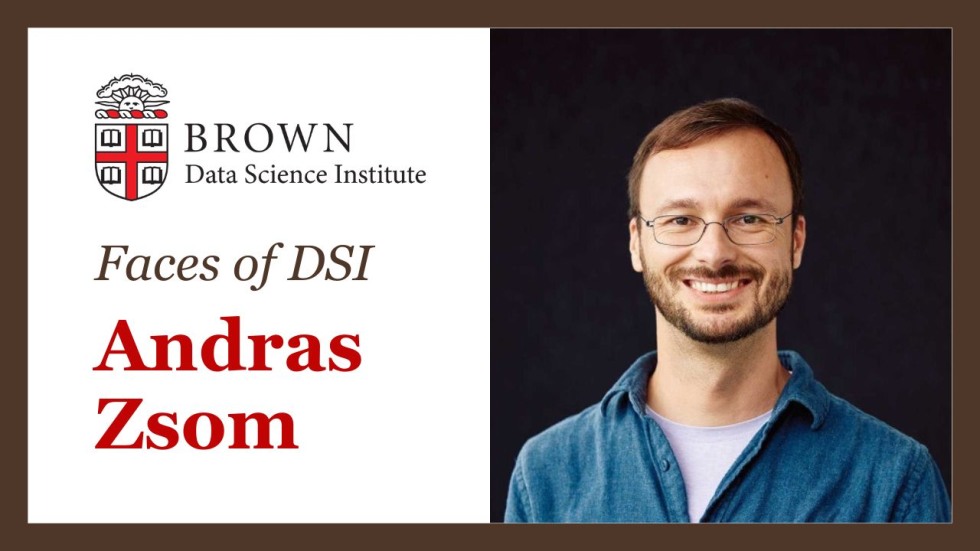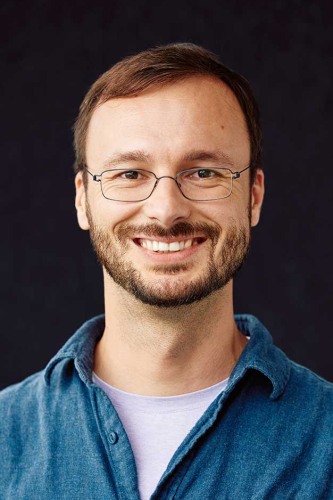A minute with Andras Zsom
DSI's Director of Graduate Studies discusses why he loves working with students, the future of our Master's Program, and his favorite fan-fiction!
Note: This interview has been edited for clarity.
Who are you and what do you do at the Data Science Institute (DSI)?
My name is Andras Zsom, and I’m an Assistant Professor of the Practice at the Data Science Institute (DSI) and the Director of Graduate Studies.
I started at Brown in 2015 as a staff data scientist, working at what is now the Center for Computation and Visualization (CCV). About three years ago, I transitioned to the DSI.
What is your background in and how did you get to this position?
That's a long journey. By training, I’m an astrophysicist. I studied astrophysics at university in Hungary, earned my PhD in Germany, and moved to the U.S. to do a postdoc at MIT. I was still focused on astrophysics at the time, but by the end of my postdoc, I experienced a tough burnout. I reflected on which parts of the job I actually enjoyed and considered what skills were in demand in industry. Data science was right at the intersection. I like coding, working with data, and discovering new things, so transitioning to data science made sense.
What does your current job entail?
I primarily do two things. I teach two of the mandatory courses in the data science master's program. One is a practical data science course, and the other is a machine learning theory course, where we dive deeper into mathematics and numerical algorithms.
I also manage the master’s program, which includes overseeing the admissions process in the spring, a big part of the job, and supporting students throughout the year. That support includes academic advising and helping students navigate personal challenges. I also handle various administrative responsibilities as they arise.
What is your most proud accomplishment since your time here?
I’m really proud of one of my courses, the practical data science course, DATA 1030: Hands on Data Science. I developed that course from scratch, so it feels like my little baby. I really enjoy teaching that course and it seems students like it as well, which is very rewarding.
In the course, I teach students how to build machine learning pipelines using the Python ecosystem. We cover data exploration using tools like pandas and matplotlib, and we use scikit-learn to develop classical machine learning models such as linear regression, logistic regression, decision trees and random forests.
The course also focuses on making machine learning models interpretable, which is important for transparency and human understanding. Throughout the semester, students work on a final project. They choose a dataset, build a machine learning model on their own, give a final presentation, and write a report on their results. It’s a really good way to wrap up the course.
What is your favorite part of your job?
Working with students is definitely my favorite part. It's challenging, and the students keep me on my toes. I’ve been teaching these courses for five years now, and every time, I get questions I don’t know the answer to. That pushes me to keep learning new things and new tools, and to stay up to date with developments in the field. I love that, it’s exciting and incredibly rewarding.
Looking back at your career path, are you surprised by where you are now?
Yeah, a bit. My mom likes to remind me that since I was six or seven, I would tell everyone I wanted to be an astrophysicist. That didn’t end up happening, but I’m still very happy with how things turned out. I think everything worked out quite well.
What goals do you have for yourself in the future?
I would like to continue improving the courses by making them more useful and relevant for students. This will be an ongoing challenge but I believe it’s important to do. Since the release of generative AI tools like ChatGPT, I’ve had to redesign most of the problem sets. Staying on top of technological advances and ensuring that we teach industry-relevant tools and methods is a major focus of mine going forward.
How are you redesigning courses to incorporate generative AI while ensuring student learning?
I approach this by developing ways to demonstrate the good and bad ways to use generative AI tools. I want students to use tools like ChatGPT and other generative AI platforms because it can help their productivity, but I also want the students to understand the limitations of the technology.
If a student uses ChaptGPT to complete an assignment without thinking, they don’t learn anything and that’s a wasted opportunity. So, I try to teach responsible use. For example, if you are writing an essay, write your own draft first and then use ChatGPT to help refine the grammar or structure. For coding, students should try solving the assignments themselves, but if they run into a bug they can’t fix, AI can be helpful for troubleshooting.
In one of our homework assignments, we require students to use ChatGPT. They start by exploring a dataset, something ChatGPT handles really well, like making visualizations or calculating summary statistics. Then we ask them to build a fairly complex machine learning pipeline, and that’s where AI tools start to struggle. The tools cannot do that, at least not yet, and the provided code is incorrect or incomplete. Students then have to debug the provided code and fix it. The assignment is a good way to show students what the tools are capable of and where they are limited.
Do you have any intuition for how courses will continue to change as this technology grows?
That’s a tough question, I honestly have no idea. If you had asked me two years ago whether I would need to redesign my courses, I would’ve said no, and yet, here we are.
That said, I believe critical thinking, rationality, and problem-solving will always be essential. The tools and methods we use will change, but the core skills will remain valuable.
Do you have any goals for the future of the Master’s Program?
Yes, a few. One goal is to gradually increase the cohort size. Another is to introduce possible specializations. As both industry and academia refine what “data science” means, we’re seeing more distinct roles emerge like database engineers, general data scientists, and machine learning engineers. I think it’s time to design tracks that align with these roles and better prepare students for their careers.
What do you do for fun outside of work?
I like reading science fiction and fantasy. I finished The Three-Body Problem a couple months ago, and I’m currently reading a collection of Chinese science fiction stories. They’re very interesting and offer a unique perspective that I haven’t seen in Western and European science-fiction.
One of my favorite books is actually a fan fiction: Harry Potter and the Methods of Rationality. It’s set in an alternate universe where Harry’s stepdad is a professor at Oxford, so Harry grows up with a love for science. When he goes to Hogwarts, he tries to understand magic using rationality, critical thinking, and scientific tools. It’s amazing.

